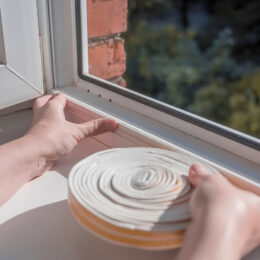
Electric radiant heating pads, left, can be placed directly under a rug to add supplemental heat to a room. Photo by Warmly Yours
I often feel chilly in my home, especially during the winter months. I know electric resistance heating can be expensive to use, but I really like the idea of in-floor heating. Does it only work with tile flooring, or can it be used under carpet? What types are available?
Electric resistance systems are expensive to use for heating the home. This is why most homes with all-electric heating use heat pumps, which are more energy efficient. Geothermal heat pumps can be several times more efficient than resistance heating and provide inexpensive central air-conditioning.
Electric in-floor heating, which can be used under tile, carpeting and hardwood, is technically no more efficient than an electric resistance furnace. However, it can be less expensive to operate because it pinpoints and improves comfort. And besides, what’s better than stepping onto a heated-tile bathroom floor in the morning?
A home loses less heat through the walls, ceiling and windows when the indoor temperature is lower. The amount of electricity used is typically several percentage points less for each degree the thermostat is set lower. With improved comfort from in-floor heating, you should be able to lower the thermostat setting considerably and not feel chilly.
Another energy saving advantage of in-floor heating is the fact that each room can have a separate thermostat, allowing you to set different temperatures in various rooms and heat as needed.
Instead of heating the room air, a warm floor radiates heat upward to your body. When one’s feet are warm, your entire body feels warm. In-floor heating reduces the extent of heat stratification where the hot air from a forced-air furnace naturally collects upward, near the ceiling.
In-floor heating is most commonly used in a concrete or tile floor with high thermal mass, but some types are specifically designed to be used under carpeting, hardwood or laminate flooring. It can actually provide better comfort under carpet and hardwood because their low thermal mass allows the system to respond faster to thermostat changes.
In a concrete slab or under a tile floor, electric heating cable is usually laid in a serpentine pattern. In one design by Nuheat, long cable guides are nailed along the outer edges of the floor. Selecting how many slots to skip between cables determines the total cable length and heat output. It also simplifies even spacing. Once the cable is in place, it is covered with concrete or thinset for tiles.
For use with carpeting, thin mats or sheets with electric cable embedded in them are placed on the floor before the carpeting is laid. The manufacturer can calculate the amount your rooms need, and the cable is available in 120 or 240 voltages. Some of the systems for smaller areas are designed for do-it-yourself installation.
WarmlyYours has a unique design with thin electric heating cables embedded in a strong fiberglass mesh. This is particularly effective for use under hardwood flooring and laminate. If you’re thinking about this option, first check with the hardwood-flooring manufacturer about the maximum allowable temperature to avoid excessive drying of the wood. Consider installing a special programmable thermostat with a laminate and engineered wood setting to protect the materials.
Another design by Heatizon uses a low-voltage heating mesh. This mesh is only about one-eighth inch thick and is stapled directly to the subflooring. Being a safe low-voltage, installation is relatively easy. WarmlyYours also offers a wafer-thin heating kit which is placed between the pad and the carpet.
With in-floor heating, you do not have to cover your entire house (or even an entire room), so you can add to the system as your budget allows. People sometimes add small custom mats or sheets in front of a mirror in a dressing area or workspace to pinpoint heating needs. At a home center store, a 10-foot-by-30-inch heating mat costs about $200, and a matching programmable thermostat is about $140.
Also, if you’re away from home for extended periods of time during winter and set your thermostats low to save energy, there’s a chance a pipe may freeze during a severe cold snap. Self-regulating electric heating cables, which attach along water pipes, are available from the in-floor heating cable manufacturers. They automatically self-adjust the heat output depending upon the temperature of the pipe.
James Dulley is a nationally syndicated engineering consultant based in Cincinnati. If you have a question about energy use or energy-efficient products, send it to: James Dulley, Electric Consumer, 6906 Royalgreen Drive, Cincinnati, OH 45244; or visit www.dulley.com.



